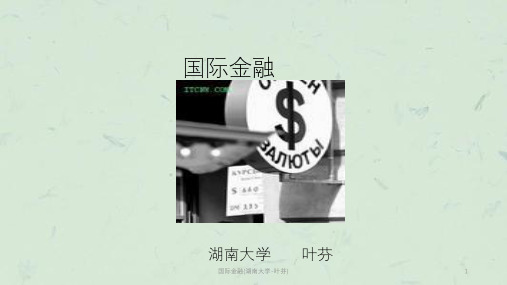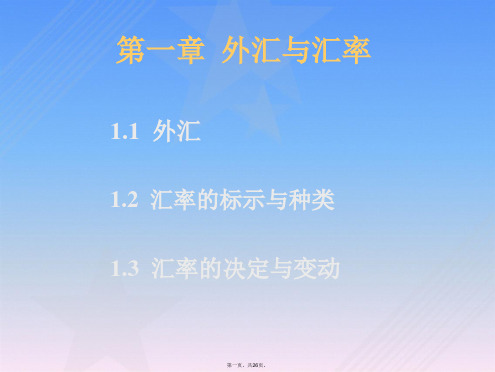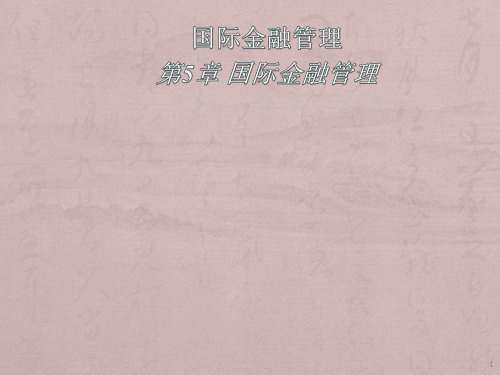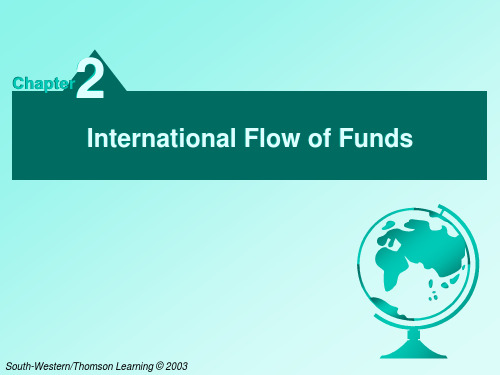国际金融管理课件(2014)
合集下载
第十一章 国际资本流动 《国际金融》PPT课件

资产组合投资的动因
跨国金融投资活动较之国内的金融投资活动 更为有效地实现风险与收益的最佳组合
资产组合的风险是各种资产自身的方差及彼 此之间的协方差之间的加权平均。如果投资者的 资产组合能够超越一个国家的范围,则不同市场 之间的较小的协方差能够降低整个资产组合风险。
国际中长期资金流动与债务危机
一、国际中长期资金流动对一国宏观经 济的影响
内部化的主要利益来自于克服外部市场的不 确定性。只要安排得当,企业通过内部化获得的利 益会远大于他们所遭受的损失。
(3) 区位因素论 该理论是由沃尔特·伊萨德等人提出的,它把传统
的关于国内资源区域配置的研究扩展到对外投资中。 区位因素论认为,跨国公司对外进行直接投资,就
像在国内要选择好合适的投资地点一样,必须力争获得 一定的区位优势以实现利润的最大化。
(银行经营性,保值性)
二、货币危机问题
1.概念 2.发生的原因 3.传播 4.影响
1.概念
广义:15%~20% 狭义:与某种汇率制度相联系
2.货币危机发生的原因
(1)经济基础变化带来的投机冲击 (2)由心理预期带来的投机冲击
经济基础变化引起的货币危机
第一,源自政府不合理的宏观政策 第二,一般过程:投机冲击导致储备急
(1)发展中国家缺乏谨慎的债务管理措施 (2)政府财政赤字严重 (3)金融扭曲导致国内资本外逃 (4)国内最根本的扭曲是不恰当的发展战略
债务危机的解决方案
1. 最初解决方案 2. 贝克计划 3. 布雷迪计划
11.3.2 国际短期资金流动与货币危机
一、概述 国际短期资金流动的三种类型 套利性 避险性 投机性
剧下降为零 第三,防范机制:紧缩性货币政策
图4-14 扩张性货币政策引起的货币危机发生过程
国际金融课件

价方法,是指不直接公布远期汇率,而只报出 即期汇率和各期的远期差额,然后再根据即期 汇率和远期差额来计算远期汇率。
远期差额=远期汇率-即期汇率
远期汇率=即期汇率+远期差额
远期差额,又称掉期率,是指某一时点上远期
汇率与即期汇率的汇率差额。
升水,远期汇率比即期汇率汇率高,这一差额
称为升水,表示期汇比现汇贵
信汇汇率是银行卖出外汇后,开具付款
委托书,用信函方式通知国外分行或代 理行解付时所采用的汇率。
票汇汇率又可分为即期票汇汇率和远期
票汇汇率。
即期票汇是指银行卖出外汇后,开具以其
在国外分行或代理行为付款人的即期汇票, 并交付给汇款人,由汇款人自带或邮寄给 收款人。收款人拿到即期汇票后,即可向 付款行进行提示付款。 适用于即期票汇的汇率成为即期票汇汇率
伦敦外汇市场 2014-09-01 09:20
CNY 1 = USD 0.1627 或 CNY 100 = USD 16.27
在这种标价方法下
,本国货币为基础货币, 外国货币为计价货币。
一定单位的本国货币折算的外币数量增
多,说明本国货币汇率上涨,即本币升 值或外币贬值。
反之,一定单位的本国货币折算的外币
价法,一为间接标价法 如果两个已知即期汇率为A币/B币和C币/A币, 一个是以A币为基础货币,另一个是以A币为 计价货币,则套汇汇率为同边相乘。
远期汇率的计算
1、远期汇率报价方法 完整汇率报价方法,又称直接报价方法,是直
接将各种不同交割期限的远期买入价、卖出价 完整的表示出来。
远期差额报价方法,又称掉期率或点数汇率报
将,或称该国货币汇率下跌。
货币升值,是指一个国家的货币对外价值的上
国际金融(湖南大学-叶芬)课件

• 主要教学方式:讲授为主,结合学生讨论
国际金融(湖南大学-叶芬)
2
第一章 国际金融概论
• 教学目的
本章主要介绍了国际金融的发展历史,国际金融的特点,以及对世界经济发 展的作用和对我国经济发展的作用。
• 教学要求
要求学生系统了解国际金融的发展历史和特点
国际金融(湖南大学-叶芬)
3
第一节 国际金融的产生和发展
二、国际金融对世界经济发展的作用 1、推动国际贸易的发展;
2、推动经济国际化的发展; 3、推动国际经济合作; 4、合理配置世界资源,提高劳动生产率(人力资源、资本资源、自然 资源、信息资源、技术资源等)
国际金融(湖南大学-叶芬)
6
第二章 国际收支
国际金融(湖南大学-叶芬)
7
第一节 国际收支和国际收支平衡表 一、 国际收支的概念
2、 记帐时间 依据权责发生制入帐,以所有权的变更日期为准
国际金融(湖南大学-叶芬)
10
五、 国际收支平衡表的分析
六、中国的国际收支平衡表
国际金融(湖南大学-叶芬)
11
第二节 国际收支调节
一、 国际收支失衡的原因 1、 周期性原因 2、 收入性原因 3、 货币性原因 4、 结构性原因
二、 国际收支调节的一般性原则 三、 国际收支自动调节机制 四、 国际收支的调节方法
国际金融
湖南大学 叶芬
国际金融(湖南大学-叶芬)
1
课程讲授大纲
• 国际金融课程共11章,教学目标:
掌握国际收支、外汇汇率、国际金融市场、国际金融体系和外汇、外债管 理的基本概念和原理;掌握外汇交易业务、国际融资业务和外汇风险防范业 务的知识和技能;系统而准确地理解西方国际收支理论、汇率理论和国际储 备理论。
国际金融(湖南大学-叶芬)
2
第一章 国际金融概论
• 教学目的
本章主要介绍了国际金融的发展历史,国际金融的特点,以及对世界经济发 展的作用和对我国经济发展的作用。
• 教学要求
要求学生系统了解国际金融的发展历史和特点
国际金融(湖南大学-叶芬)
3
第一节 国际金融的产生和发展
二、国际金融对世界经济发展的作用 1、推动国际贸易的发展;
2、推动经济国际化的发展; 3、推动国际经济合作; 4、合理配置世界资源,提高劳动生产率(人力资源、资本资源、自然 资源、信息资源、技术资源等)
国际金融(湖南大学-叶芬)
6
第二章 国际收支
国际金融(湖南大学-叶芬)
7
第一节 国际收支和国际收支平衡表 一、 国际收支的概念
2、 记帐时间 依据权责发生制入帐,以所有权的变更日期为准
国际金融(湖南大学-叶芬)
10
五、 国际收支平衡表的分析
六、中国的国际收支平衡表
国际金融(湖南大学-叶芬)
11
第二节 国际收支调节
一、 国际收支失衡的原因 1、 周期性原因 2、 收入性原因 3、 货币性原因 4、 结构性原因
二、 国际收支调节的一般性原则 三、 国际收支自动调节机制 四、 国际收支的调节方法
国际金融
湖南大学 叶芬
国际金融(湖南大学-叶芬)
1
课程讲授大纲
• 国际金融课程共11章,教学目标:
掌握国际收支、外汇汇率、国际金融市场、国际金融体系和外汇、外债管 理的基本概念和原理;掌握外汇交易业务、国际融资业务和外汇风险防范业 务的知识和技能;系统而准确地理解西方国际收支理论、汇率理论和国际储 备理论。
国际金融 第一章 课件

1.3汇率的决定与变动
1.3.1金本位货币制度下决定汇率的基 础——铸币平价
1£ =$4.8665( 113.0016格令/23.22格 令)
固定汇率不是一成不变的,以黄金输 送点作为汇率的上下波动的界限。
英、美之间运送1£黄金的费用为0.03 $,则上下限为:4.8965、4.83易汇率1352金融汇率19811984年136按政府允许使用的汇率种类多少1361单一汇率1362复汇率137按银行汇兑外汇的方式1371电汇汇率1372信汇汇率1373票汇汇率138按汇率制度1381固定汇率1管理机构公开发布的外汇汇率
EURO1=USD1.2000/1.2020 1.2.2.1地点、时间 1.2.2.2两个价位——买价、卖价 1.2.2.3五个数字 1.2.2.4“点”的概念:0.0001(25个基本 点=0.25%=0.0025) 1.2.2.5简便报价:1.20是大数、20是小数。 可报00/20或1.2000/20 1.2.2.6批发汇率:100万美元以上交易
贸易差额恶化,经过一段时间以后再使 贸易差额得到改善的状况,即指贬值有 使贸易收入先下降后上升的效果。人们 认为汇率贬值在短期内对改善贸易差额 非但不能奏效,反而会使贸易差额更趋 严重,只有经过一段时滞以后,才能使 贸易收入增加,达到改善国际收支状况 的目的。这一过程或者说贬值与收入这 种变化关系的函数图像类似大写的英文
减免
第十五页,共26页。
1.3.9.3有效汇率
是指某种加权平均汇率。目前,国际货币基金组织 定期公布17个工业发达国家的若干种有效汇率指数, 包括劳动力成本、消费物价、批发物价等为权数的 经加权平均得出的不同类型的有效汇率指数。
其中,以贸易比重为权数的有效汇率反映的是一
国际金融管理ppt课件

10.9% 1.1105 1.03 1
.
1.045
9
+ 通过在国外证券交易所交叉挂牌会给公司带来信息披露,上市,财务 报告等方面的额外费用。但是这有助于国外的股东更加容易地以本币 获得公司股票,这无疑增强了公司流通股票的流动性。
+ 交叉挂牌也避免了本国资本市场分隔和流动性不佳带来的定价错误, 有助于提高股票的价格。
18
+ 得自国外分支机构的收入可以对应在国外缴纳的 税款予以税收优惠(tax credits),直至与在美国 的边际税率相等。通常情况下,税收优惠以相等 的额度从母公司的纳税义务中扣减在国外缴纳的 税款。如果国外的公司所得税率大于35%,可以 对母公司高于35%的部分给予递延的税收优惠; 或者与其他低于35%税率的国外收入结合,将税 率更为经济地抵减至35%。
场售价低50%。如果外部市场为完全竞争市场,那么 将趋于无穷大,最优转移价格等于中间产品市场价格。 + 如果外部市场为完全竞争市场,那么将趋于无穷大, 最优转移价格等于中间产品市场价格。
16
+ 关贸总协定(GATT)和世界贸易组织(WTO)管 理着国外分支机构的税收待遇。如果分支机构位 于签约国,它将有权享受“国民待遇”,即其税 收和监管待遇不能比该国本土企业差。
付30美元,余下部分则用股票支付。 + 那么A公司将需要支付多少股股票呢?在支付30
美元后,A公司的价值将为140美元。在此种情况 下,a = 30/140 = .21428571429。
35
+ 现金和股票收购
30 20
nw
140 1 30
5.45455
140
第一章 国际收支《国际金融学》PPT课件

二、国际收支平衡表的编制原则
国际收支平衡表是按照复式簿记法(Double Entry)来编制的。复式簿记法是国际会计的通 行准则,其基本原理是:任何一笔交易发生, 必然涉及借方(Debit)和贷方(Credit)两个方面, 即有借必有贷,借贷必相等,因此任何一笔交 易都要以同一数额记两次,一次记在借方,一 次记在贷方。凡是引起外汇收入或外汇供给的 交易,即资产减少、负债增加都列入贷方,或 称正号项目(Plus Items);凡是引起外汇支出 或外汇需求的交易,即资产增加、负债减少, 都列入借方,或称负号项目(Minus Items)。
发达国家国际收支不平衡的原因和特点表现为:第 一,商品、劳务、资本输入过多或不足的直接原因主 要是国际竞争力、利润率和未经抵补的利息率的变化。 第二,资本项目在国际收支中的地位日趋重要,资本 输出、输入频繁且不稳定。第三,由于高度一体化的 全球国际金融市场上资金对有资信的国家来说是充裕 的,因而较易发生的是国际储备过多(而不是不足)的 情形。
(一)贸易收支差额
贸易收支差额是指一国进出口收支差 额。尽管贸易项目仅仅是国际收支的 一个组成部分,不能代表国际收支的 整体,但是,对于某些国家来说,贸 易收支在全部国际收支中所占比重相 当大,以至于经常性的把贸易收支作 为国际收支的近似代表。
(二)经常账户差额
经常账户包括贸易收支、服务收支、 收入和经常性转移收支,前两项构成经 常账户收支的主体。虽然经常账户的收 支也不能代表全部国际收支,但它综合 反映了一个国家的进出口状况(包括服 务贸易),而被各国广为使用,并被当 作是制定国际收支政策和产业政策的重 要依据。
20世纪60年代以来,国际收支危机开始 频频爆发,货币危机理论迅速成为理论界关 注的焦点之一,经济学家先后建立了三代国 际收支危机模型(或货币危机模型)。
国际金融管理课件(2014)

C15- 16
Asian Crisis
• As a result of the 1997-1998 Asian Crisis, MNCs realized
that they had underestimated the potential financial problems that could occur in the high-growth Asian countries. Country risk analysis had concentrated on the high degree of economic growth,even though the Asian countries had high debt levels and their commericial banks were typically not required to disclose much information about their loans. Some MNCs recognized the potential problems in Asia, though,and discontinued their exports to those Asian businesses that were not willing to pay in advance.
C15- 14
• Second, a change in a foreign government
could result in new tax laws and other restrictions imposed on subsidiaries of U.S. firms or firms from any other country that are based there.
《国际金融学》PPT课件全

现代国际金融学时期
以布雷顿森林体系为研究背景,分析 国际货币制度演变及国际金融市场发 展。
国际金融学的研究方法
实证分析方法
运用统计数据和计量经济学工具,对国 际金融现象进行定量分析和检验。
案例分析方法
通过对典型国家或地区的国际金融实 践进行案例分析,提炼经验和教训。
规范分析方法
基于经济学原理和国际金融理论,对 国际金融问题进行定性分析和逻辑推 理。
国际资本流出可分散母国投资风险,获取更高收益;但也可能导致 母国产业空心化、失业率上升等问题。
对全球经济的影响
国际资本流动推动了全球范围内的资源配置优化和经济增长;但同 时也加剧了全球经济波动和风险传递。
国际资本流动的管理与政策
01
管理措施
02
实行外汇管制:通过对外汇的买卖、兑换和转移进行限制 ,控制国际资本流动。
04
CATALOGUE
国际金融市场
国际金融市场概述
1 2
定义
国际金融市场是指由国际性的资金借贷、结算、 汇兑以及有价证券、黄金和外汇的买卖活动所组 成的市场。
功能
国际金融市场的主要功能包括资金融通、外汇买 卖、风险管理、国际结算以及信息传递等。
3
分类
根据交易性质的不同,国际金融市场可分为货币 市场、资本市场、外汇市场、黄金市场以及衍生 金融工具市场等。
牙买加体系
1976年牙买加协议确立了以浮动汇率制为主导的国际货币体系,各国 可自由选择汇率制度,国际储备货币多元化。
布雷顿森林体系
建立背景
二战后,美国经济实力空前膨胀,黄金储备占全球70%以 上,为建立以美元为中心的国际货币体系奠定了基础。
主要内容
美元与黄金挂钩,其他国家货币与美元挂钩,实行可调节 的固定汇率制度;成立国际货币基金组织和世界银行两大 国际金融机构。
第十章 国际结算 《国际金融实务》PPT课件

(进口商)
(5)
受益人 (出口商)
(11)
(10)
(2)
(3)
开证行/
(8)
付款行
(9)
(4)
(6)
(7)
通知行/ 议付行
❖ (1) 买卖双方经过磋商,约定以信用证方式进行结算; ❖ (2)进口方向开证行递交开证申请书,约定信用证内容,并支付押金或提
供保证人; ❖ (3)开证行接受开证申请书后,根据申请开立信用证,正本寄给通知行,
❖ (三)信用证的关系人及其权利和义务
❖ 信用证结算方式的基本关系人有四个:即开证申 请人、开证行、通知行和受益人。此外还有其他 关系人,如保兑行、议付行、付款行或偿付行、 转证行等。
❖ (四)信用证的内容 ❖ 1.信用证的当事人 ❖ 开证申请人(买方):APPLICANT ❖ 开证行:OPENING BANK, ISSUING BANK ❖ 通知行:ADVISING BANK ❖ 受益人(卖方):BENEFICIARY ❖ 议付行:NEGOTIATION BANK
❖ 2.委托人与银行之间的法律关系是基于双方签订的《保函委 托书》而产生的委托担保关系。《保函委托书》中应对担保 债务的内容、数额、担保种类、保证金的交存、手续费的收 取、银行开立保函的条件、时间、担保期间、双方违约责任、 合同的变更、解除等内容予以详细约定,以明确委托人与银 行的权利义务。
❖ 银行保函业务中涉及到的主要当事人有三个:委托人 (Principal)、受益人(Beneficiary)和担保人(Guarantor), 此外,往往还有反担保人、通知行及保兑行等。
❖ 1.委托人与受益人之间基于彼此签订的合同而产生的债权债 务关系或其他权利义务关系。此合同是它们之间权利和义务 的依据,相对于保函协议书和保函而言是主合同,它是其他 两个合同产生和存在的前提。
国际金融课件 第一章

1 元(人民币) =4.680 圓(新台币)
Slide 1-22
fsxycyf@
*直接报价法和间接报价法
(1)直接标价法(Direct Quotation),又称为 应付标价法。即以一定单位(1个外币单位或100 等)的外国货币为标准,折成若干单位的本国货 币来表示。 (2)间接标价法( Indirect Quotation ),又称 为应收标价法,是以一定单位(1个本币单位或 100、10000等)的本国货币为标准,折算成若干 单位的外国货币来表示。
算的支付手段。 外汇三要素 (1)国际性,普遍接受性 (2)可兑换性 (3)可偿性
Slide 1-7 fsxycyf@
二、外汇形态
外币现钞
(可自由兑换的)
票据
汇票
本票 支票
外币支付凭证 广 义
狭义
外币信用卡
外币存款
外币有价证券
其它金融资产
Slide 1-8
国际债券 国际股票 可转让存款单
外汇兑换牌价
币别
Currency
中间价
Middle A
买入价
Buying B
卖出价 Selling C 828.94
现钞买入价 Bank Notes 807.84
美元
827.70
826.46
说明:
A=(B+C)/2 银行买入 银行卖出 运费+保险费
公布汇率 客户卖出 客户买入 2-3‰
Slide 1-34
Slide 1-32
fsxycyf@
2、从银行买卖外汇的角度区分: (1)买入汇率(Buying Rate) (2)卖出汇率(Selling Rate) (3)中间汇率(Middle Rate) (4)现钞价(Bank Note Rate)
国际金融管理课件(2014)

C2 - 19
• For example, a floating exchange rate
system may correct a trade imbalance automatically since the trade imbalance will affect the demand and supply of the currencies involved.
C2 - 28
• Privatization(私有化)
¤ DFI
• Potential Economic Growth
¤ Countries
Factors Affecting DFI
• Tax Rates
¤ Countries
that impose relatively low tax rates on corporate earnings are more likely to attract DFI. will typically prefer to invest their funds in a country when that country’s currency is expected to strengthen.
• • • • •
1.Monetary Gold(货币性黄金) 2.Special Drawing Rights(特别提款权) 3.Reserve Position in the Fund(基本提 款权) 4.Foreign Exchange(外汇) 5.Other Claims
C2 - 12
(4) Errors and Omission
• Errors and Omission(错误与遗漏帐户) • 一切统计上的误差最终都归于此帐户
第四章外汇、汇率和外汇市场《国际金融》PPT课件

汇率变动影 响一国的通 货膨胀程度
第4章
外汇、汇率和外汇市场
4.2 汇率的决定与变动
4.2.3 汇率变动对经济的影响
3.汇率变动对世界经济的影响
小国汇率变动只会对贸易伙伴国经济产生轻微的影响,主要工业国汇率的变 动则不然。
第一,主要工业国的货币贬值至少在短期内会不利于其他工业国和发展中国 家的贸易收支,由此可能引起贸易战和汇率战,并影响世界经济的景气。
(2)不规定纸币的含金量
布雷顿森林体系崩溃后,以美元为中心的固定汇率制解体,各国政府不再规定纸币的 含金量,纸币的价值不再以金量体现,而是以其所具有的购买一定数量商品的能力表 现出来,因此,纸币所代表的价值一般来说表现在纸币的购买力上。按照等价交换的 原则,两种货币兑换比率的客观基础,应该是两种货币购买力的对比,也称为购买力 平价。它基本上体现了纸币流通中所代表的真实价值的对比。所以这一时期决定汇率 的基础是购买力平价。
外汇、汇率和外汇市场
4.3.1 固定汇率制度
1.固定汇率制度的类型 (3)两种固定汇率制度的比较 ①汇率的调节机制不同。 ②制度形成的基础不同。 ③汇率稳定程度不同。
第4章
4.3 汇率制度
外汇、汇率和外汇市场
4.3.1 固定汇率制度
2.固定汇率制度的优缺点
(1)固定汇率制度的优点
由于固定汇率制使两国货币比价基本固定,或汇率的波动范围被限制在一定 幅度之内,它就便于经营国际贸易、国际信贷与国际投资的经济主体进行成 本和利润的核算,也使进行这些国际经济交易的经济主体面临汇率波动的风 险损失较小,而有利于这些国际经济交易的进行与发展,因而有利于世界经 济的发展。
(1)金本位制度下的固定汇率制
在金本位制度下,固定汇率制是自发形成的。各国金币的含金量是决定各国 中心汇率的基础。并且金币自由兑换、自由铸造和熔化、自由输出入的原则 能自动保证现实汇率的波动不超过黄金输送点。在金本位制度下,汇率变化 的幅度很小,基本上是固定的。在这种汇率制度下,各个国家的汇率保持相 对稳定。
国际金融PPT课件

进出口为例加 以说明。 • 1. 美国一出口商出口了价值100000美 元的商品,而对方以同等价值的另一种商品 相抵,则美国的国际收支平衡表的贷方记入 100000美元(商品出口),而借方记入 100000美元(商品进口)。 • 2. 以存款支付贷款。美国出口200000 美元的商品到德国,德国进口商以他在美国 的银行存款200000美元支付,则形成美国对 国外的负债减少200000美元。前者记入贷方 (商品出口),后者记入借方(国外负债减 少)。
• 3. 出口商接受外国货币的支付。美国出口 150000美元商品到英国,两国进出口商商 定以相当于150000美元的英镑支付。这样 在美国的国际收支平衡表上贷方记入 150000美元(商品出口),借方记入 150000美元(国外资产增加,即美国的外 汇持有量增加)。 • 4. 美国一居民向其国外眷属赠送价值8000 美元的商品,形成8000美元的商品出口, 记入贷方。然而这一输出并没有产生收入, 对应的借方科目为“私人单方面转 移”8000美元。
= 综合差额
- 储备增加(或+储备减少)
= 零
• • • • • •
1.3.2 国际收支失衡的性质及影响 1.周期性失衡(Cyclical Disequilibria) 2.结构性失衡(Structure Disequilibria) 3.货币性失衡(Money Disequilibria) 4.所得性失衡(Income Disequilibria) 5.偶然性失衡
第1章 国际收支
• 1.1 国际收支的基本概念 • 1.1.1 国际收支的含义
•
国际收支(Balance of Payments)即为 国际间的外汇收支,反映一个国家在一定 时期(通常为一年)内同其它国家在政治、 经济、文化等方面交往所发生的外汇收 支的总和。一国的国际收支经常是不平 衡的。如果收支大于支出,有了盈余, 这个差额就叫国际收支顺差(Surplus); 如果支出大于收入,则出现亏损,这个 差额就叫国际收支逆差(Deficit).一般在 顺差之前,冠以“+”号(多省略);在逆差之 前,冠以“-”号,或以红字书写表示国际 收支发生了赤字。
• 3. 出口商接受外国货币的支付。美国出口 150000美元商品到英国,两国进出口商商 定以相当于150000美元的英镑支付。这样 在美国的国际收支平衡表上贷方记入 150000美元(商品出口),借方记入 150000美元(国外资产增加,即美国的外 汇持有量增加)。 • 4. 美国一居民向其国外眷属赠送价值8000 美元的商品,形成8000美元的商品出口, 记入贷方。然而这一输出并没有产生收入, 对应的借方科目为“私人单方面转 移”8000美元。
= 综合差额
- 储备增加(或+储备减少)
= 零
• • • • • •
1.3.2 国际收支失衡的性质及影响 1.周期性失衡(Cyclical Disequilibria) 2.结构性失衡(Structure Disequilibria) 3.货币性失衡(Money Disequilibria) 4.所得性失衡(Income Disequilibria) 5.偶然性失衡
第1章 国际收支
• 1.1 国际收支的基本概念 • 1.1.1 国际收支的含义
•
国际收支(Balance of Payments)即为 国际间的外汇收支,反映一个国家在一定 时期(通常为一年)内同其它国家在政治、 经济、文化等方面交往所发生的外汇收 支的总和。一国的国际收支经常是不平 衡的。如果收支大于支出,有了盈余, 这个差额就叫国际收支顺差(Surplus); 如果支出大于收入,则出现亏损,这个 差额就叫国际收支逆差(Deficit).一般在 顺差之前,冠以“+”号(多省略);在逆差之 前,冠以“-”号,或以红字书写表示国际 收支发生了赤字。
国际金融管理课件(2014)

C10 - 16
Ⅲ Hedging long-term transaction exposure
• Firms commonly use three techniques to
hedge long-term transaction exposure:
• (1) long-term forward contract • it can be set up for very creditworthy
• To suggest other methods of reducing
exchange rate risk when hedging techniques are not available.
C10 - 2
ⅠTransactixists when the
currency that is highly correlated with the currency of concern may be hedged instead.
• The stronger the positive correlation
between the two currencies, the more effective this cross-hedging (交叉套期保 值)strategy will be.
C10 - 10
(4) currency option hedge
• A currency option hedge involves the use
of currency call or put options to hedge transaction exposure.
C10 - 11
Using Currency Call Options for Hedging Payables
Ⅲ Hedging long-term transaction exposure
• Firms commonly use three techniques to
hedge long-term transaction exposure:
• (1) long-term forward contract • it can be set up for very creditworthy
• To suggest other methods of reducing
exchange rate risk when hedging techniques are not available.
C10 - 2
ⅠTransactixists when the
currency that is highly correlated with the currency of concern may be hedged instead.
• The stronger the positive correlation
between the two currencies, the more effective this cross-hedging (交叉套期保 值)strategy will be.
C10 - 10
(4) currency option hedge
• A currency option hedge involves the use
of currency call or put options to hedge transaction exposure.
C10 - 11
Using Currency Call Options for Hedging Payables
- 1、下载文档前请自行甄别文档内容的完整性,平台不提供额外的编辑、内容补充、找答案等附加服务。
- 2、"仅部分预览"的文档,不可在线预览部分如存在完整性等问题,可反馈申请退款(可完整预览的文档不适用该条件!)。
- 3、如文档侵犯您的权益,请联系客服反馈,我们会尽快为您处理(人工客服工作时间:9:00-18:30)。
C4 - 4
ⅡExchange Rate Equilibrium
• An exchange rate represents the price of a
currency, which is determined by the demand for that currency relative to the supply for that currency.
C4 - 18
Exchange rate between foreign currency and the dollar
example
• Assume that Morgan Co., a U.S.-based MNC,
commonly purchase supplies from Venezuela bolivar and the Japanese yen. Morgan’s financial analysts have developed the following one-year projections for economic conditions:
C4 - 21
Ⅳ Anticipated Exchange Rates Speculation
• Many commercial banks attempt to
Strengthened
C4 - 16
Factors that Influence Exchange Rates
(6)Interaction of Factors
• Trade-related factors and financial factors
sometimes interact. Exchange rate movements may be simultaneously affected by these factors..
C4 - 20
Tips
• Capital flows have become larger over
time and can easily overwhelm trade flows. For this reason, the relationship between the factors that affect trade and exchange rates is not always as strong as one might expect.
rate is determined; and
• To examine the factors that affect the
equilibrium exchange rate.
C4 - 2
ⅠMeasuring Exchange Rate Moe rate measures the value of
S1 S0 D1 D0 Quantity of £
alue of £ r1 r0
U.S. inflation U.S. demand for British goods, and hence £. British desire for U.S. goods, and hence the supply of £.
Chapter
4
Exchange Rate Determination
South-Western/Thomson Learning © 2003
Chapter Objectives
• To explain how exchange rate movements
are measured;
• To explain how the equilibrium exchange
C4 - 8
Factors that Influence Exchange Rates
Real Interest Rates
• A relatively high interest rate may actually
reflect expectations of relatively high inflation, which discourages foreign investment.
C4 - 9
Factors that Influence Exchange Rates
Relative Interest Rates
•
real nominal interest interest – inflation rate rate rate Fisher effect.
• This relationship is sometimes called the
C4 - 7
Factors that Influence Exchange Rates
(2)Relative Interest Rates
S0 S1 D0 D1 Quantity of £
alue of £ r0 r1
U.S. interest rates U.S. demand for British bank deposits, and hence £. British desire for U.S. bank deposits, and hence the supply of £.
C4 - 3
Online Application
• For the latest exchange rates, visit:
¤ / ¤ /
¤ /
¤ /
one currency in units of another currency.
• When a currency declines in value, it is
said to depreciate(贬值). When it increases in value, it is said to appreciate(升值).
C4 - 17
How Factors Can Affect Exchange Rates
Trade-Related Factors 1. Inflation Differential 2. Income Differential 3. Gov’t Trade Restrictions Financial Factors 1. Interest Rate Differential 2. Capital Flow Restrictions U.S. demand for foreign goods, i.e. demand for foreign currency Foreign demand for U.S. goods, i.e. supply of foreign currency U.S. demand for foreign securities, i.e. demand for foreign currency Foreign demand for U.S. securities, i.e. supply of foreign currency
• 2)assume that U.S. and Japan conduct
very little international trade but frequently engage in capital flow transactions. how about the future value of Japanese yen?
Value of £ $1.60 $1.55 $1.50 S: Supply of £
equilibrium exchange rate
D: Demand for £ Quantity of £
C4 - 6
Ⅲ Factors that Influence Exchange Rates
(1)Relative Inflation Rates
C4 - 10
Factors that Influence Exchange Rates
(3)Relative Income Levels
£/$ r1 r0
U.S. income level U.S. demand for S0 ,S1 British goods, and hence £. D1 No expected change for D0 the supply of £.
Expectations Signal 1.Poor U.S. economic indicators
Impact on $ Weakened
2.Fed chairman suggests Fed is Strengthened unlikely to cut U.S. interest rates 3.A possible decline in German Strengthened interest rates 4.Central banks expected to Weakened intervene to boost the euro
Quantity of £
C4 - 11
Factors that Influence Exchange Rates
(4)Government Controls
• Governments may influence the
equilibrium exchange rate by: ¤ imposing foreign exchange barriers, ¤ imposing foreign trade barriers, ¤ Intervening(干预) in the foreign exchange market, and ¤ affecting macro variables such as inflation, interest rates, and income levels.
• • • •
factor Change in Inflation rate
